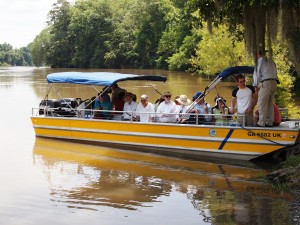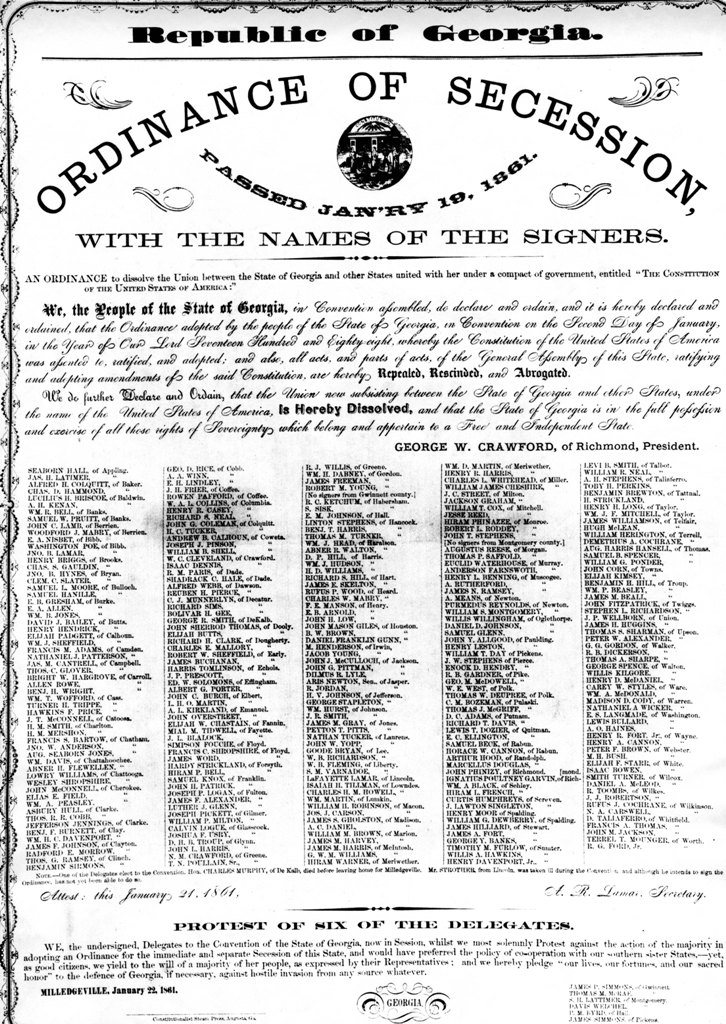Dr. Ed Ayers discussion on the causes of the war
Dr. Ed Ayers, president of the University of Richmond, was the visiting scholar for week one’s discussion on the causes of the war. To listen to his lecture, please click below.
Part 1
Part 2
Part 3
Part 4
To see the audio index, click here.
__________________________________________________________
March to the Sea: Ebenezer Creek
Week one’s field trip took the participants on a two hour boat trip up the Savannah River to Ebenezer Creek, site of the drowning of fugitive slaves following the Union army. The boat left the dock at River Street in downtown Savannah at 9 a.m. and along the way the group learned about the history of the rice plantations that spread out along the banks of the Savannah River north of town.  Remnants of the old rice fields were visible and everyone soaked up the scenery of the tall cypress trees as we passed by. We arrived at Ebenezer around 11 a.m. and, after the boat docked, made the short hike up the road to the Jerusalem Lutheran Church, which was founded in 1734 by the Salzburgers. After exploring the grounds of the historic church and cemetery, including a look at the remains of the Old Augusta Road that U.S. General Jefferson Davis used during his advance on Savannah, the group had lunch at the New Ebenezer Retreat and Conference Center before returning to the bo
Remnants of the old rice fields were visible and everyone soaked up the scenery of the tall cypress trees as we passed by. We arrived at Ebenezer around 11 a.m. and, after the boat docked, made the short hike up the road to the Jerusalem Lutheran Church, which was founded in 1734 by the Salzburgers. After exploring the grounds of the historic church and cemetery, including a look at the remains of the Old Augusta Road that U.S. General Jefferson Davis used during his advance on Savannah, the group had lunch at the New Ebenezer Retreat and Conference Center before returning to the bo at. Back on the water, the boat left the river and entered into Ebenezer Creek. Large cypress trees grew out of the swampy waters, and everyone had their eyes peeled for alligators. The group arrived at the site of the crossing, now marked by trash and remnants of the pilings of an old wooden bridge. U.S. Gen. Jeff. C. Davis crossed Ebenezer Creek with his 14th Army Corps as it advanced toward Savannah during Gen. William T. Sherman’s March to the Sea. Davis hastily removed the pontoon bridges over the creek, and hundreds of freed slaves following his army drowned trying to swim the swollen waters to
at. Back on the water, the boat left the river and entered into Ebenezer Creek. Large cypress trees grew out of the swampy waters, and everyone had their eyes peeled for alligators. The group arrived at the site of the crossing, now marked by trash and remnants of the pilings of an old wooden bridge. U.S. Gen. Jeff. C. Davis crossed Ebenezer Creek with his 14th Army Corps as it advanced toward Savannah during Gen. William T. Sherman’s March to the Sea. Davis hastily removed the pontoon bridges over the creek, and hundreds of freed slaves following his army drowned trying to swim the swollen waters to  escape the pursuing Confederates. Following a public outcry, Sec. of War Edwin Stanton met with Sherman and local black leaders in Savannah on January 12, 1865. Four days later, President Lincoln approved Sherman’s Special Field Orders No. 15, confiscating over 400,000 acres of coastal property and redistributing it to former slaves in 40-acre tracts. After floating near the site for awhile to discuss the event, the boat returned to the river and quickly made its way toward Savannah, outrunning the usual June afternoon thunderstorm.
escape the pursuing Confederates. Following a public outcry, Sec. of War Edwin Stanton met with Sherman and local black leaders in Savannah on January 12, 1865. Four days later, President Lincoln approved Sherman’s Special Field Orders No. 15, confiscating over 400,000 acres of coastal property and redistributing it to former slaves in 40-acre tracts. After floating near the site for awhile to discuss the event, the boat returned to the river and quickly made its way toward Savannah, outrunning the usual June afternoon thunderstorm.
Dr. Todd Groce, president and CEO of GHS, talks about the movement of Sherman’s 14th Army Corps, leading up to the controversial and tragic events at Ebenezer Creek.
__________________________________________________________
From the Collection
MS1361-BS
Georgia Ordinance of Secession
JK9784 .A15 1861
Journal of the public and secret proceedings of the Convention of the people of Georgia: held in Milledgeville and Savannah in 1861: together with the ordinances adopted
Includes communications from commissioners and officers of other states relative to secession, the constitution of the Confederate States of America, etc.



